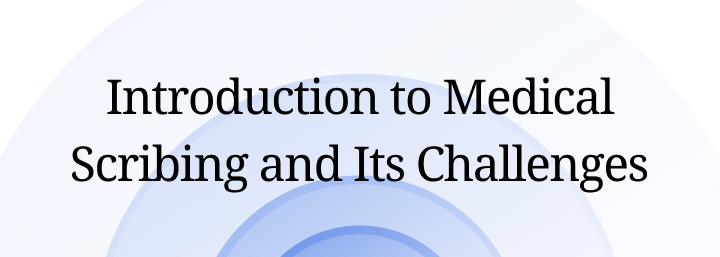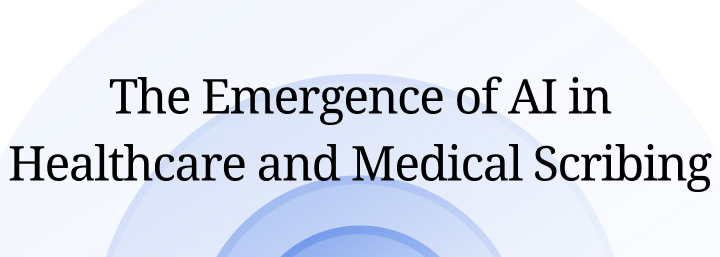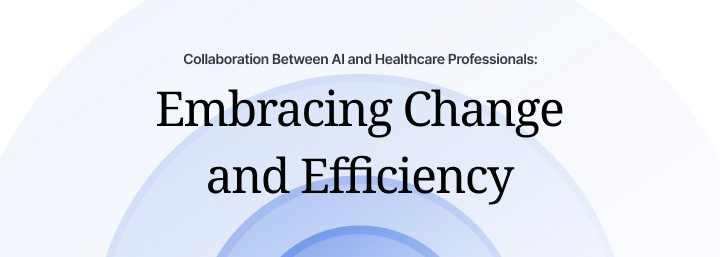How Has AI Revolutionized Medical Scribing?
Table of Contents
As a healthcare provider, you know how important it is to document your patient encounters accurately and comprehensively. Medical documentation is essential for patient care and legal, ethical, and financial purposes. However, you also know how challenging and time-consuming it can be to create and maintain medical records. You may have to spend hours after each shift typing or dictating notes, coding and billing, and updating electronic health records (EHRs). You may also have to deal with issues such as poor documentation quality, inconsistency, errors, incompleteness, etc. These issues can affect productivity, quality of care, patient satisfaction, reimbursement, and liability.
You may have tried different solutions to improve your documentation process, such as hiring medical scribes, using voice recognition software, or outsourcing transcription services. However, these solutions may need to meet your needs and expectations.
What if there was a better way to document your patient encounters? How can you save time and money, improve your documentation quality and accuracy, integrate seamlessly with your EHR system, and provide you with real-time assistance and decision support? A way that can leverage the power of artificial intelligence (AI) to automate and enhance the process of medical scribing?
In this blog post, we will introduce you to using AI for medical scribes. We will explain what AI medical scribe is, how it works, its advantages in clinical settings, the challenges and limitations that need to be overcome, and how it can benefit different specialties in healthcare.
The Role of AI in Revolutionizing Medical Scribing
AI is the branch of computer science that deals with creating machines or systems that can perform tasks that normally require human intelligence, such as reasoning, learning, decision-making, natural language processing, computer vision, speech recognition, etc. AI has rapidly advanced and transformed various domains and industries, including healthcare. AI applications in healthcare can range from diagnosis and treatment to research and management. One of the areas where AI can have a significant impact is medical scribing. AI can revolutionize medical scribing by using its technologies and capabilities to automate and enhance the process of creating and maintaining medical records. In this section, we will explain what medical scribing is, what are its challenges, and how AI can overcome them.
Introduction to Medical Scribing and Its Challenges

Medical scribing is creating and maintaining accurate and comprehensive medical records for patients during their visits to healthcare providers. Medical scribes are trained professionals who assist physicians and other clinicians by documenting patient interactions, such as history taking, physical examination, diagnosis, treatment plan, prescriptions, referrals, and follow-ups.
Medical scribing is a vital service that can improve the quality of care, patient satisfaction, and physician productivity. However, it also poses several challenges for both healthcare providers and scribes. Some of these challenges are:
High demand and shortage of qualified medical scribes in the market.
High cost and time required to train and retain medical scribes.
Variability and inconsistency in the quality and accuracy of medical documentation.
Distraction and disruption caused by the presence of a third party in the patient-physician encounter.
Integrating medical records with electronic health records (EHRs) systems is difficult and complex.
The Emergence of AI in Healthcare

AI is becoming a big help in healthcare, especially medical scribing. Medical scribing is like taking notes during a doctor's visit. Instead of the doctor writing everything down, AI can do it. It listens carefully to what the doctor and patient say and turns it into words on a computer. This is super useful because it lets the doctor focus on the patient and not worry about writing. Plus, it keeps all the important information in one place so the doctor can look back at it later. But remember, even though AI is good at this job, humans still check to ensure everything is accurate. So, AI and doctors are working together to make medical visits smoother and more helpful for everyone. Some general examples of AI applications in healthcare are:
Image analysis and interpretation for radiology, pathology, dermatology, etc.
Natural language processing and text generation for clinical documentation, coding, billing, etc.
Machine learning and deep learning for predictive analytics, risk stratification, personalized medicine, etc.
Speech recognition and synthesis for voice-based interfaces, dictation, transcription, etc.
Computer vision and augmented reality for surgical guidance, telemedicine, education, etc.
How AI Medical Scribes Work
AI-powered medical scribes are software systems that use AI technologies to automate the process of medical scribing. These innovative tools can capture the patient-physician conversation using speech recognition or ambient sensors, extract the relevant information using natural language processing and understanding, generate a structured and standardized medical record using natural language generation, and integrate it with the EHR system using application programming interfaces (APIs).
AI medical scribes can work in different modes depending on the preference and workflow of the healthcare provider. Some of these modes are:
| Mode | Method |
|---|---|
Fully automated mode | It works independently without any human intervention or supervision. It listens to the patient-physician conversation, creates the medical record, and uploads it to the EHR system. |
Semi-automated mode | It works collaboratively with a human scribe or a physician. It listens to the patient-physician conversation, creates a draft of the medical record, and allows the human scribe or physician to review, edit, or approve it before uploading it to the EHR system. |
Assisted mode | It works as an assistant or a tool for a human scribe or a physician. It listens to the patient-physician conversation, provides suggestions or prompts for documentation, coding, billing, etc., and allows the human scribe or physician to create the final medical record. |
The Advantages of AI Medical Scribes in Clinical Settings
AI medical scribes can offer several benefits for healthcare providers and patients in clinical settings. Some of these benefits are:
Enhanced Documentation Efficiency and Accuracy
AI-driven medical scribe systems can improve the efficiency and accuracy of medical documentation by reducing the time and effort required to create and maintain medical records. These systems can also reduce errors and inconsistencies in medical documentation by following standardized templates and guidelines. According to a study by AAFP Innovation Lab, this innovation dramatically reduced documentation time by 62% during the clinic and 76% during after-hours.
Time and Cost Savings
AI medical scribes have the potential to economize time and expenses for healthcare providers by alleviating them from the weight of documentation duties. This, in turn, enables them to concentrate further on patient care and clinical results. Additionally, this technology can trim down waiting periods and enhance healthcare accessibility, leading to time and cost savings for patients.
Integration with Electronic Health Records (EHRs)
AI medical scribes can integrate seamlessly with EHR systems using APIs or other methods. This can facilitate the exchange and interoperability of health information among different stakeholders. This integration can also enhance the usability and functionality of EHR systems by providing voice-based or natural language-based interfaces, data visualization, analytics, etc.
Real-time Assistance and Decision Support
AI medical scribes can provide real-time assistance and decision support for healthcare providers by using natural language processing and generation, machine learning, and deep learning. Their capabilities extend to tasks such as:
Documentation: Provide suggestions or prompts for documentation, coding, billing, etc., based on the patient-physician conversation and the clinical context
Diagnosis: Provide differential diagnosis or confirmatory diagnosis based on the patient’s symptoms, history, physical examination, laboratory tests, imaging studies, etc
Education: Provide education or information for healthcare providers or patients on topics such as disease prevention, management, complications, etc
Naturally, this serves as a broad overview. The operational approach varies among different medical scribe provider systems, with each offering distinct services that might only encompass some of these aspects or could diverge from them.
Overcoming Challenges and Ensuring Effective Implementation
Integrating AI-driven scribe systems into healthcare practices is challenging and challenging; they present a landscape that demands careful consideration. Among the issues that necessitate attention and resolution are:
Ensuring Data Security and Privacy
AI medical scribes must ensure the security and privacy of the health data they collect, process, store, and transmit. It must comply with relevant laws and regulations, such as the US Health Insurance Portability and Accountability Act (HIPAA) or the EU's General Data Protection Regulation (GDPR). These platforms must also implement appropriate measures such as encryption, authentication, authorization, auditing, etc., to protect the data from unauthorized access, use, disclosure, modification, or deletion.
Training and Familiarization with AI Scribing Systems
AI-powered scribing systems must provide adequate training and familiarization for healthcare providers and patients on using and interacting with AI scribing systems. AI medical scribes must ensure that physicians and patients are comfortable and confident using AI scribing systems. These systems also need to provide feedback and support for clinic managers and patients to improve their experience and satisfaction with AI scribing systems.
Exploring the Benefits of AI Medical Scribes in Different Specialties
AI medical scribes can be beneficial for different specialties in healthcare. Some examples of specialties are:
Primary care: Physicians can use AI medical scribes to reduce their documentation workload and improve patient engagement. It can also help primary care physicians with diagnosis, treatment, referral, follow-up, etc.
Emergency medicine: Emergency medicine physicians can use AI medical scribes to improve documentation speed and accuracy in a fast-paced, high-stress environment. These innovative systems can also help emergency medicine physicians with triage, diagnosis, treatment, disposition, etc.
Surgery: Surgeons can use these platforms to improve their documentation quality and completeness in a complex and technical setting. AI medical scribes can also help surgeons with preoperative evaluation, intraoperative guidance, postoperative care, etc.
Psychiatry: Psychiatrists can use this new possibility to enhance documentation reliability and consistency in a sensitive and subjective setting. AI scribes can also help psychiatrists assess, diagnose, treat, monitor, etc.
Collaboration between AI and Healthcare Professionals: Embracing Change and Efficiency

AI is not a replacement or a threat to healthcare professionals. Rather, it is a partner and an enabler for them. AI can augment and complement the skills and expertise of healthcare professionals by providing them with tools and solutions that can improve their efficiency, accuracy, quality, satisfaction, etc.
They must embrace the change and efficiency AI can bring to their practice. Healthcare professionals must adopt a positive attitude and a growth mindset toward AI. They also need to learn how to leverage the power of AI by understanding its capabilities, limitations, benefits, risks, etc.
AI is not perfect or infallible. It is still evolving and improving. Therefore, healthcare professionals need to be vigilant and responsible when using AI. Healthcare professionals need to monitor and evaluate the performance of AI by using metrics such as accuracy, reliability, validity, etc. Healthcare professionals must also report and correct errors or issues using AI.
Conclusion
AI is transforming the field of medical scribing by using its technologies and capabilities to automate and enhance the process of creating and maintaining medical records. AI medical scribes can offer several advantages for healthcare providers and patients, such as improved documentation efficiency and accuracy, time and cost savings, integration with EHRs, and real-time assistance and decision support. AI medical scribes can also benefit from different specialties in healthcare, such as primary care, emergency medicine, surgery, and psychiatry.
AI can augment and complement the skills and expertise of healthcare professionals by providing them with tools and solutions that can improve their efficiency, quality, satisfaction, etc. They must embrace the change and efficiency AI can bring to their practice. They also need to be vigilant and responsible when using AI.
We have a solution for you if you want to learn more about AI in medical scribing or experience the benefits of AI medical scribing yourself. Meet Tali, an AI ambient scribe and medical dictation tool. Tali is an AI-powered software that can listen to patient encounters, create accurate and comprehensive medical records, and integrate them with your EHR system. It is easy to use, secure, reliable, and compatible with different devices and platforms and can help you save time, reduce costs, improve quality, enhance satisfaction, etc. Tali can help you focus more on patient care and clinical outcomes.
Take advantage of this opportunity to discover Tali, the AI medical scribe. Experience the benefits of Tali with our free trial today.
Documentation and Administrative Tasks?